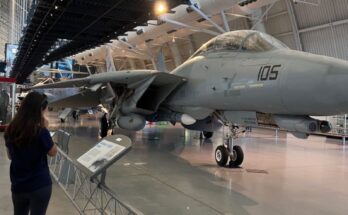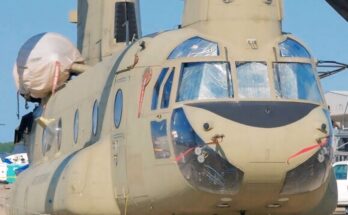
The Boeing CH-47 Chinook is one of the most recognizable helicopters in the world, and its appearance when fully prepared for battle is a striking symbol of strength, readiness, and reliability. With its twin rotors, massive fuselage, and heavy-lift capability, the Chinook is designed to carry troops, supplies, and equipment wherever they are needed. But when it is suited for combat operations, the helicopter takes on its final, battle-ready look—a configuration that reflects both power and purpose.
At first glance, the Chinook’s imposing size sets it apart. Measuring nearly 100 feet in length with tandem rotor blades stretching overhead, its silhouette is unmistakable. In combat, this profile is often painted in low-visibility camouflage schemes—flat greens, browns, or grays depending on the theater of operations. These colors help the helicopter blend with its surroundings, whether it is flying through mountainous terrain, dense forests, or desert landscapes.
Externally, the Chinook’s battle-ready configuration includes a variety of mission-essential features. Large side doors and a rear loading ramp stand open, ready to deploy troops or vehicles quickly. The helicopter is often fitted with defensive systems such as flare and chaff dispensers to protect against missile threats. Additionally, pintle-mounted machine guns are installed at the side doors and ramp, allowing crew members to provide suppressive fire during insertions or extractions. This final look transforms the Chinook from a transport platform into a heavily defended aircraft capable of operating in hostile environments.
The interior of the CH-47 also reflects its readiness for combat. The spacious cargo hold can be configured for a variety of missions. Rows of red webbed seats line the cabin for troop transport, while cargo tie-down points anchor heavy loads such as artillery, vehicles, or ammunition pallets. When suited for medical evacuation, litters and medical gear are secured inside. This adaptability gives the Chinook a final form that is always tailored to the specific mission at hand.
Equally important are the external loads the helicopter can carry. With three cargo hooks beneath its fuselage, the Chinook is able to lift vehicles, artillery pieces, or supply containers as sling loads. In battle, this means the aircraft can deliver heavy firepower or logistical support directly to the front lines. Seeing a Chinook flying low with a Humvee or howitzer suspended beneath it is a vivid image of how the helicopter is “suited for battle.”
The final preparations for a combat mission also involve the crew. Pilots and crew members wear flight suits, helmets, and body armor, while their positions inside the aircraft reflect practiced coordination. Gunners take their posts, load ammunition, and prepare to scan the skies and ground for threats. The combination of the helicopter’s physical configuration and the crew’s readiness completes the battle look of the CH-47.
In summary, the CH-47 Chinook’s final look when suited for battle is a blend of power, adaptability, and defense. From its camouflage exterior and mounted weapons to its versatile cargo space and sling-load capacity, the Chinook is unmistakably built for the demands of combat. It is not just a helicopter—it is a flying workhorse, always prepared to carry the fight forward and bring its mission to completion.
Would you like me to also create a visual description or infographic-style breakdown of the CH-47’s “final look” (weapons, camouflage, crew positions, cargo) for your presentation?


